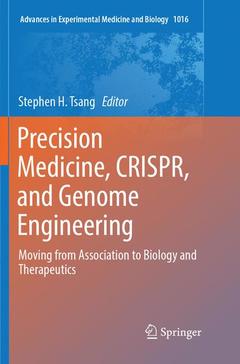Description
Precision Medicine, CRISPR, and Genome Engineering, Softcover reprint of the original 1st ed. 2017
Moving from Association to Biology and Therapeutics
Advances in Experimental Medicine and Biology Series, Vol. 1016
Coordinator: Tsang Stephen H.
Prefaced by: Church George M.
Language: English
Subjects for Precision Medicine, CRISPR, and Genome Engineering:
Keywords
Genetically Modified; gRNA Design; Ophthalmologic Disease; ZFN; TALEN
Publication date: 09-2018
Support: Print on demand
Publication date: 11-2017
Support: Print on demand
Description
/li>Contents
/li>Biography
/li>Comment
/li>
Part 1. Introduction to the CRISPR Revolution.- 1. Viral Vectors, Engineered Cells and the CRISPR Revolution.- 2. Combining Engineered Nucleases with Adeno-associated Viral Vectors for Therapeutic Gene Editing.- Part 2. CRISPR in Model Systems.- 3. From Reductionism to Holism: Toward a More Complete View of Development through Genome Engineering.- 4. Genome Engineering in Mice.- 5. Genome Editing to Study Ca2+ Homeostasis in Zebrafish Cone Photoreceptors.- 6. From Prokaryotic Immune Systems to Plant Genome Editing Tools.- 7. Part 3. The Future of CRISPR.- 7. Using High-throughput Gene Editing to Identify Therapeutic Targets in the Noncoding Genome.- 8. CRISPR in the Retina: Evaluation of Future Potential.- 9. The Future of CRISPR Applications in the Lab, the Clinic and Society.
For years, Stephen Tsang has been culturing embryonic stem (ES) cells and created the first mouse model for a recessive form of retinitis pigmentosa by applying homologous recombination to ES cell technology. Two elements define his laboratory. First, by leveraging his genetics clinical practice, in which over 1000 retinal patients are cared for, he brings an array of clinical resources to his research, including stem cells and live imaging data. Second, he and his students are recognized authorities in a broad array of state-of-the-art technologies. Most recently, he was invited as a Moderator for the Gene Editing/Rewriting the Genome session during the 65th American Society of Human Genetics Annual Meeting.
These books may interest you

CRISPR in Animals and Animal Models 135.60 €

MicroinjectionMethods and Protocols 137.14 €

MicroinjectionMethods and Protocols 210.99 €

